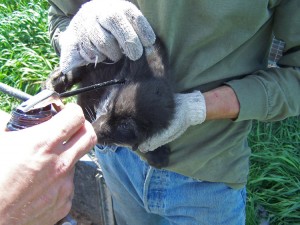This is reported as being a sporadic problem, in Norway, in blue foxes. It is transmitted by healthy appearing femlaes to unborn young. Most in a litter will die. Symptoms include loss of balance, weakness, and convulsions.
Laboratory test reveal brain and kidney infections in acute cases. Arteries are involved in chronic cases.
There is no treatment for this disease.
Fox Diseases. Novia Scotia Dept. of Agriculture and Marketing Livestock Service.
Coccidia is a protozoan parasite that will cause loose or bloody stools and unthriftiness. It can be diagnosed easily with a fecal exam. It will usually affect juvenile animals as adults can develop immunity against the parasite.
Treatment with Corid is the easiest way to control this parasite.
These are microscopic internal parasites. Several other protozoans such as sarocysts and toxoplasmosis, have been reported, but appear of little overall importance.
Fox Diseases. Novia Scotia Dept. of Agriculture and Marketing Livestock Service. Updated 8/16/12 by Hugh Hildebrandt DVM, Medford Veterinary Clinic.
These are mite infections of the skin. While common in wild foxes, it appears to be less common under ranch conditions. Female mites burrow just under the skin to lay eggs. This causes severe irritation and itching. The skin is rough and inflamed. Skin scrapings submitted to the laboratory will often reveal the mites (Figure VIII). A number of treatments (baths) are available and will work, especially early in the condition. Ivomec will also prevent and treat most mange mites.
Fox Diseases. Novia Scotia Dept. of Agriculture and Marketing Livestock Service.

Mineral oil is added to the young fox’s ears to prevent of ear mites.
These are very common in foxes. Black debris and irritated ears (internal) are suggestive. Irritation is due to mites deep in the ear canal. They are very small but easily seen under a microscope in the laboratory. In severe cases, mites can spread to skin around the ears.
Mites should be controlled to reduce irritation and the chance of secondary infection.
Routine treatment with mineral oil is good. This treatment is better if an insecticide is included. One used for dogs and cats containing rotenone would be safe for foxes, but this requires frequent treatment. Mites are also treated with a standard dewormer such as Ivomec.
Fox Diseases. Novia Scotia Dept. of Agriculture and Marketing Livestock Service.
These are a more serious problem in young animals. The worms are active blood suckers in the gut causing anemia, dark stools and death if present in large numbers. Their life cycle is somewhat similar to roundworms. However, infective larvae can also penetrate skin to cause infection. Larvae migration before kits are born is not a very important source of infection. The most important way is through the vixen’s milk. Worms mature in the gut of kits by three weeks and each can suck up to 0.12 cc of blood per day, this causing the clinical signs.
Ivomec and Panacur are effective means of treatment for hookworms.
Fox Diseases. Novia Scotia Dept. of Agriculture and Marketing Livestock Service. Updated 8/16/12 by Hugh Hildebrandt DVM, Medford Veterinary Clinic.
This happens in all species, including foxes. A study in Norway was done on 47 vixens, both young and old, which did not produce. Seventy percent had implantation zones which meant fetuses died early in life. Others which had normal litters had 20 percent more implantation zones that live fetuses.
The causes in foxes are not understood, but in other species include viral infections, hormonal imbalances, and stress.
Fox Diseases. Novia Scotia Dept. of Agriculture and Marketing Livestock Service.
Some females will not come into heat. Hormones can be used to do this if no heat is evident near the end of the breeding season. Work in Norway suggests the following. Give subcutaneous injections (under the skin) daily of 100 IU pregnant mare serum gonadotrophin (PMSG) for up to five days. On the first day of heat, give one injection of 200 IU of human chorionic gonadotrophin (HCG). This treatment resulted in 100 percent pregnancies.
Caution is necessary, as a second Norway experiment shows seven pregnant animals were given several shots of 200 IU of HCG during the last half of pregnancy. Five had prolonged pregnancies of which three were induced to deliver with steroids. Caesarian sections on the other two revealed degenerate fetuses.
Therefore, care must be taken not to use those hormones on animals which may be pregnant.
Fox Diseases. Novia Scotia Dept. of Agriculture and Marketing Livestock Service.
Russian workers carried out a atudy on two groups of foxes. One had been selected over a number of years for quietness and ease of handling. The second group was wild and aggressive. Animals were killed and brains analyzed for serotonin (a natural tranquilizer). The quiet group had a much higher level.
This research indicates considerable value in the selection of quiet animals for breeding stock.
Fox Diseases. Novia Scotia Dept. of Agriculture and Marketing Livestock Service.
This is seen occasionally in foxes. It is usually connected with shedding of the coat. Often, infections such as ringworm are involved. Animals may bite themselves until they bleed. Deep sores may develop around the tail and thighs. Impacted anal glands are occasionally found and should be squeezed. Fur chewing can also be a vice, and related to nervousness.
Other changes which may help are moving to another pen, vitamin B complex, tranquilizers and collars, if severe.
Fox Diseases. Novia Scotia Dept. of Agriculture and Marketing Livestock Service.
This poison was seen when herring was preserved with sodium nitrate. Heating to produce herring meal resulted in formation of DMNA. This highly toxic poison causes severe liver damage. Animals lose appetite and have abundant fluid in the abdomen. Post mortem shows severe liver degeneration. Sodium nitrate is no longer used to preserve fish so this poisoning should not be seen.
Fox Diseases. Novia Scotia Dept. of Agriculture and Marketing Livestock Service.

